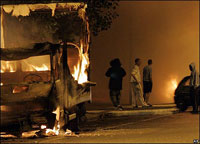80 police officers hurt in riots in Paris suburbs
As many as 80 police officers were injured in rioting in the Paris suburbs that took a potentially deadly new turn as youths used firearms against police.

The violence overnight Monday to Tuesday was more intense than during three weeks of rioting in 2005, said a senior police union official, Patrice Ribeiro. He said "genuine urban guerrillas with conventional weapons and hunting weapons" were among the rioters. Of the 82 injured officers, about 30 were fired at with buckshot, Ribeiro told The Associated Press.
The violence was triggered by the deaths of two teens in a crash with a police car Sunday in Villiers-le-Bel, a blue-collar town in Paris' northern suburbs.
Residents claimed the officers left the scene without helping the teens, whose motorbike collided with the car. Officials cast doubt on the claim, but the internal police oversight agency was investigating.
Rioting and arson first erupted Sunday night in Villiers-le-Bel. It grew worse and spread Monday night to other towns north of Paris. Rioters hurled stones and petrol bombs at police.
The use of firearms added a dangerous new dimension. Guns were rarely used in the 2005 riots, which spread to poor housing projects nationwide. Youths, many of them Arab and black children of immigrants, again appeared to be lashing out at police and other targets seen to represent a French establishment they feel has left them behind.
Suspicion of the police and government officials runs high among residents of the bland housing project where the two teens who were both black were killed. They were identified in French media only by their first names, Lakhami, 16, and Mouhsin, 15.
The rioting did not seem racially motivated, but there have long been tensions between France's largely white police force and ethnic minorities trapped in poor neighborhoods with high unemployment. Despite decades of problems and heavy state investments to improve housing and create jobs, the depressed projects that ring Paris are a world apart from the glitzy boulevards and tourist attractions of the French capital. Police speak of no-go zones where they and fire fighters fear to patrol.
"The problem of bad relations between the police and minorities is underestimated," said criminologist Sebastien Roche.
Police are facing "a situation that is far worse than that of 2005," said Ribeiro, national secretary of the Synergie officers union.
"Our colleagues will not allow themselves to be fired upon indefinitely without responding," he warned on RTL radio. "They will be placed in situations which will become untenable."
President Nicolas Sarkozy, speaking from China, appealed for calm and called a security meeting with his ministers for Wednesday, on his return to France. The violence and the use of firearms against officers presented his government, in officesince his election victory in May, with a stern test.
The rioting youth "want Sarkozy. They want him to come and explain" what happened to the two teens, said Linda Beddar, a 40-year-old mother of three in Villiers-le-Bel. Beddar woke Tuesday to find the library across from her house a burned-out shell, after youths set in on fire the night before.
Sarkozy was interior minister, in charge of police, during the riots of 2005, giving him hands-on experience of this type of urban unrest. The violence two years ago also started in the suburbs of northern Paris, when two teens were electrocuted in a power substation while hiding from police.
The government appears keen to avoid a repeat of the 2005 violence.
"We will not let go. We will fight with all the force the nation is capable of," Prime Minister Francois Fillon told firefighters in Villiers-le-Bel. He promised reinforced security measures for Tuesday night, and several trucks of riot police were on the outskirts of town Tuesday.
Fillon spoke with a firefighter who was shot by the rioters and handled the bullet that was extracted from the man's arm.
Hunting weapons are widespread in France, and police generally carry guns. Residents of Villiers-le-Bel, however, expressed surprise that the rampaging youth were using firearms.
On Monday night, youths were seen firing buckshot at police and reporters. A police union official said a round from a hunting rifle pierced the body armor of one officer, who suffered a serious shoulder wound.
"Police officers were targeted with hunting weapons; a certain number of them were wounded by lead shot. This is totally unacceptable," said Interior Minister Michele Alliot-Marie. She said there were six serious injuries, "people who notably were struck in the face and close to the eyes."
Several hundred youths organized in small groups led the rioting in Villiers-le-Bel, and incidents were also reported in five other towns north of Paris, the regional government said in a statement.
It refused to give specific figures on injuries among the police, rioters or other civilians, or the numbers of cars and buildings seton fire, saying it feared that doing so would encourage youths to try to wound even more officers and destroy even more property in nights to come.
In Villiers-le-Bel, arsonists set fire to the municipal library and burned books littered its floor. Shops and businesses were also attacked and more than 70 vehicles were torched, authorities said. Rioters rammed burning cars into buildings, trying to set them on fire, authorities said. Police made six arrests, authorities said.
"The violence has escalated," said police union leader Jean-Claude Delage. "Young thugs today don't think twice about shooting a gun, big calibers, at the forces of order."
Subscribe to Pravda.Ru Telegram channel, Facebook, RSS!


